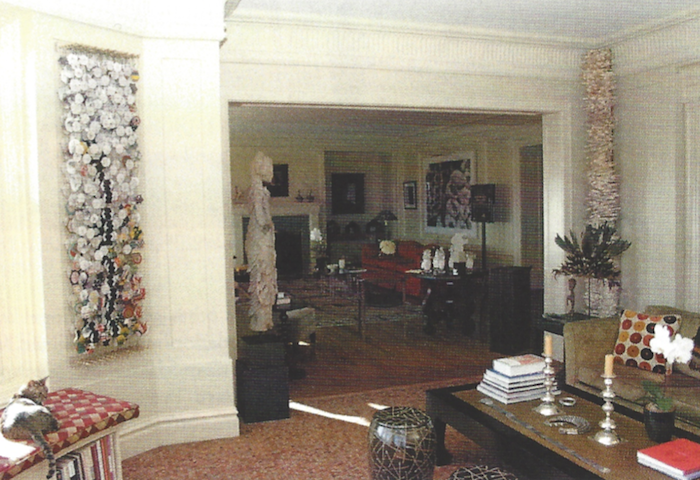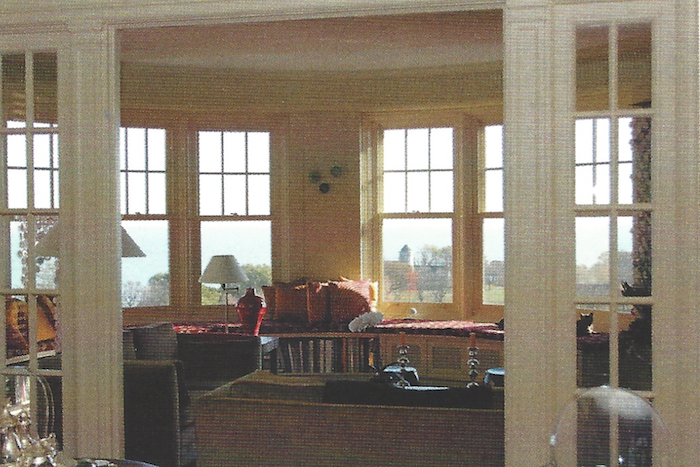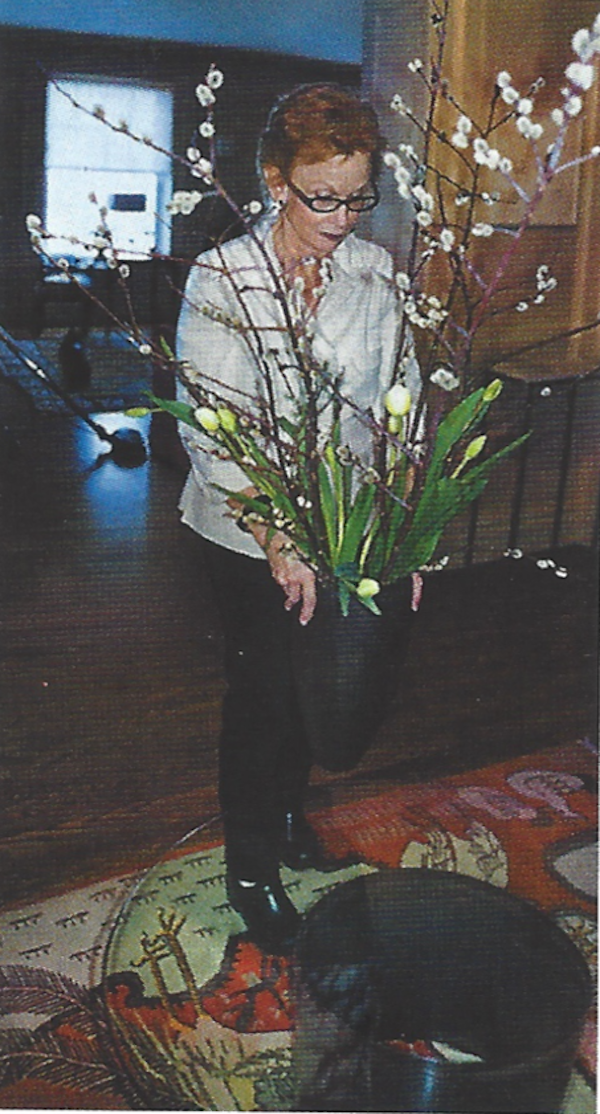Collector Conversations: Deone Jackman


By GINNY VAN ALYEA
I drove to visit Deone Jackman at her home in Hyde Park on a perfect fall Chicago morning. Lake Shore Drive was wide open, and Lake Michigan was colored an ideal shade of cerulean blue, enhanced by the drapery of orange leaves still clinging to the trees along the bike path. Hyde Park often feels like an escape from downtown to me, but until I stepped into the entryway of Deone's 9th floor lake front apartment, I had no idea just what awaited me.
*
Deone says she has always collected things from her travels. Judging by the many exotic artifacts and statues from far away lands placed throughout her apartment, she must have logged many miles to find so many striking objects.
"As a kid I was always cutting things out of magazines and putting them up on walls, long before I had actual art to display," she says.
Deone's entree into serious art collecting did not begin in a small way when she acquired work by two of Chicago's most well-known artists: Roger Brown and Jim Nutt. She remembers the acquisitions as "big, compelling, scary purchases."
Though I had come to her apartment to talk to her about her art collection, Deone told me upfront that she still thinks the idea of being 'an art collector' is rather grandiose – a familiar, but somewhat vexing topic for those considered by others to be collectors. Regardless of how Deone chooses to view her history of buying and living with art, there is no disputing that her Hyde Park home invites discovery. Deone has covered the walls with remarkable and varied works of art I immediately recognize – pieces by Ed Paschke, Kerry James Marshall, Cheonae Kim, Judy Ledgerwood, Curtis Mann, Jin Soo Kim and Gladys Nilsson – and she has filled her life with enduring relationships with many Chicago artists.
Behind many of these works on display are relationships. One which Deone is particularly proud of is the one she's developed with the Hyde Park Art Center (HPAC). A passionate supporter of the Center, it's clear that HPAC has given her a great deal in return. At least a few of the artists whose works may be found throughout Deone's sprawling home, such as Cat Chow, were discovered through HPAC's Not Just Another Pretty Face (NJAPF) program – a biennial benefit that pairs patrons with artists. Patrons select an artist they'd like to work with – in a given price range – they meet the artist, establish a budget and then discuss the commission to be created. After a period of more than a year, a catalogue featuring contrasting perspectives on the experience is published, and the final works are unveiled at a special reception at HPAC in front of patrons and the artists. NJAPF artists split their commission with HPAC, and the program encourages a new group of people to support contemporary artists, as well as understand the joys and possibilities of commissioning artwork. As Deone attests because NJAPF builds very personal bonds between patrons and artists, it can lead to long term support for the creation of art in Chicago.
*

Deone has had the pleasure of enjoying several artistic collaborations. After encountering a series of kite constructions by Jacob Hashimoto at a private event at the MCA Warehouse, she decided she had her own project for the artist. Deone wanted Hashimoto to expand on what he'd done at the MCA and create hundreds of his small kites to install in the ceiling of her second home in Michigan. It turned out to be a 2 1/2 year project, and she ended up with about 2,000 kites to cover not just part but the entire ceiling – a breathtaking result of what seemed at the time like a chance encounter.
Deone admits she's a bit impulsive when making some purchases, but she smiles when she confesses she sometimes has to rearrange rooms. "That's the joy of it," she says. Changing things up often means they don't become part of the wallpaper, but Deone also has always felt compelled to arrange objects – so much so that her late husband was always asking her to just sit down.
As a visitor, certain groupings become apparent, like the area in Deone's office, that she refers to as her "Wall of Women," including works by artists such as Mickalene Thomas and Julia Fish. But for the most part the way the collection has come together is idiosyncratic. The variety in Deone's collection is apparent in the inclusion of quite a number of antiques, which complement, even soften, the contemporary art. A wood, slant front desk looks at home in the dining room by a large-scale Roger Brown, while an elegant side table beneath two works on paper by Judy Ledgerwood adds an appropriate delicacy.
*
More meaningful than the art works themselves are the relationships Deone has with the artists. "Any artist I collect, if it make sense to become friends, I love to know them. It's incredibly important in collecting – more so than the objects."
She says she considers Chicago an accessible place to get to know artists and therefore to collect art. Deone things it's partly the nature of the city, but she also believes that many artists who choose to live and work in Chicago are inclined to build honest relationships with collectors.

One of Deone's closest artist relationships is with Theaster Gates, a fellow HPAC supporter. Deone became interested in what Gates was doing with his Dorchester Project, and she was moved by his focus on bringing about positive, creative changes throughout the arts to the Woodlawn neighborhood – an area of town Deone says most Hyde Parkers had long been told to stay clear of because of the risk of danger and violence. She sees Gates's artistic, as well as geographic, choice as a compelling investment in personal life as well as urban space, and she says she appreciates that she has been able to watch his project take shape and expand. Endeavors like The Dorchester Project, which began as a way to transform a poor area of Chicago through reinventing abandoned buildings and creating inviting, cultural spaces while challenging notions of economics, race, and the status-quo, have helped Deone understand how complex the art world can be for an artist who must balance the demands to be successful while also doing what they desire. "You learn about the pressures artists face and the choices they must make. I feel really privileged because it feels like a personal experience for me. Theaster is open about what it's like, and I admire his willingness to share with the community and with me. He doesn't make it a mysterious process."
Our tour of the apartment finished in the sitting room, where we could admire the view of Lake Michigan and Promontory Point, almost as much as Deone's two lazy cats were enjoying the midday fall sunlight. Deone returned to her favorite topic, the Hyde Park Art Center, when we began to discuss why openness in art is so critical to the collecting process and to exposing the joy of exploring contemporary art.
There are some leaders in the art community who are constantly striving to make art accessible and to make it a living subject. Deone says, "HPAC is such a facilitator of this. They help make art understandable, comfortable." It is undoubtedly her greatest art relationship.
There will always be preconceptions to refute about contemporary art, barriers to break through and effort to put in in order to learn and better understand, but just as any relationship – friendly or romantic – progresses through many stages of development, a love of art can begin with butterflies of excitement and end as a deep and enduring companionship.






